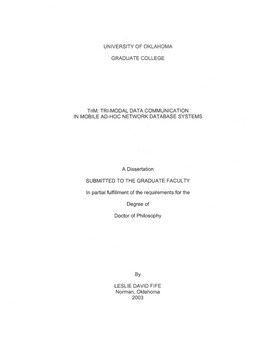| dc.contributor.advisor | Gruenwald, Le, | en_US |
| dc.contributor.author | Fife, Leslie David. | en_US |
| dc.date.accessioned | 2013-08-16T12:19:09Z | |
| dc.date.available | 2013-08-16T12:19:09Z | |
| dc.date.issued | 2003 | en_US |
| dc.identifier.uri | https://hdl.handle.net/11244/662 | |
| dc.description.abstract | The Mobile Ad-hoc Network (MANET) is an emerging area of research in the network and database communities. A MANET is a group of self-organizing, autonomous clients and servers that form temporary networks. A MANET allows three methods of data communication. These are: data broadcast, data query and peer-to-peer communication. The primary research in this area has been in MANET routing. Node mobility, disconnection, battery power and limited bandwidth form the constraints for MANET data communication research. | en_US |
| dc.description.abstract | TriM was designed to accommodate disconnection and reconnection to the network through periodic synchronization. Data communication was designed to provide contention free data broadcast. Each part of the protocol was designed with minimum power consumption as a goal. | en_US |
| dc.description.abstract | Simulation showed TOM minimized the average power consumption of servers and clients while accommodating node disconnection. The research also demonstrates the transmission ranges needed to get acceptable performance in large regions where the number of servers is limited. Simulation was also used to compare TriM to Gruenwald's Leader Selection protocol. This comparison showed TriM operated at similar and lower average power consumption rates while providing a greater range of data communication methods. Analysis of TriM demonstrated the benchmark was capable of accurately predicting the simulation performance of TriM under a wide range of scenarios. | en_US |
| dc.description.abstract | The objective of this research is twofold. First, a MANET data communication protocol, TriM (for Tri-Modal Communication), capable of providing all three methods of data communication in a single network is designed. This is the first MANET protocol capable of providing all three methods of MANET data communication. Second, a benchmark capable of evaluating MANET data communication protocols is developed. This is the first benchmark developed for the MANET environment. | en_US |
| dc.description.abstract | The developed benchmark has three parts. These are a standard MANET architecture, data communication workload and evaluation criteria. This benchmark allows the evaluation and comparison of MANET data communication protocols and is used to evaluate TriM. | en_US |
| dc.format.extent | xv, 222 leaves : | en_US |
| dc.subject | Computer networks. | en_US |
| dc.subject | Computer Science. | en_US |
| dc.subject | Mobile computing. | en_US |
| dc.subject | Data transmission systems. | en_US |
| dc.title | TriM: Tri-modal data communication in mobile ad-hoc network database systems. | en_US |
| dc.type | Thesis | en_US |
| dc.thesis.degree | Ph.D. | en_US |
| dc.thesis.degreeDiscipline | School of Computer Science | en_US |
| dc.note | Source: Dissertation Abstracts International, Volume: 64-10, Section: B, page: 5033. | en_US |
| dc.note | Adviser: Le Gruenwald. | en_US |
| ou.identifier | (UMI)AAI3109057 | en_US |
| ou.group | College of Engineering::School of Computer Science | |
